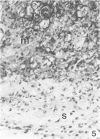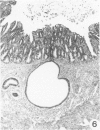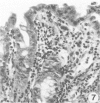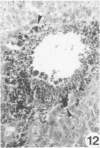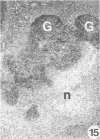Abstract
The pathogenesis of experimentally induced cecal amebiasis in gerbils (Meriones unguiculatus) was studied from 5 to 60 days after inoculation. Ulcerative lesions were noted 10 to 60 days after inoculation. The sequential development of lesions was asynchronous and progressed from destruction of the interglandular epithelium and of glandular crypt elements to loss of mucosa and formation of granulomatous lesions in the submucosa involving the muscularis mucosae. Pathologic changes in the liver correlated with the formation of ulcerative cecal lesions. Subacute hepatic changes showed lymphocytic portal infiltrate, Kupffer cell hyperplasia, multinucleated giant cells, granuloma formation, and sinusoidal mononuclear and granulocytic infiltrates. Metastatic amebic liver abscesses occurred as early as 10 days after inoculation, and small abscesses were found in the portal areas of the right liver lobe. The sequential development and pathologic manifestation of the infection and the usefulness of the gerbil for the study of human intestinal amebiasis are discussed.
Full text
PDF
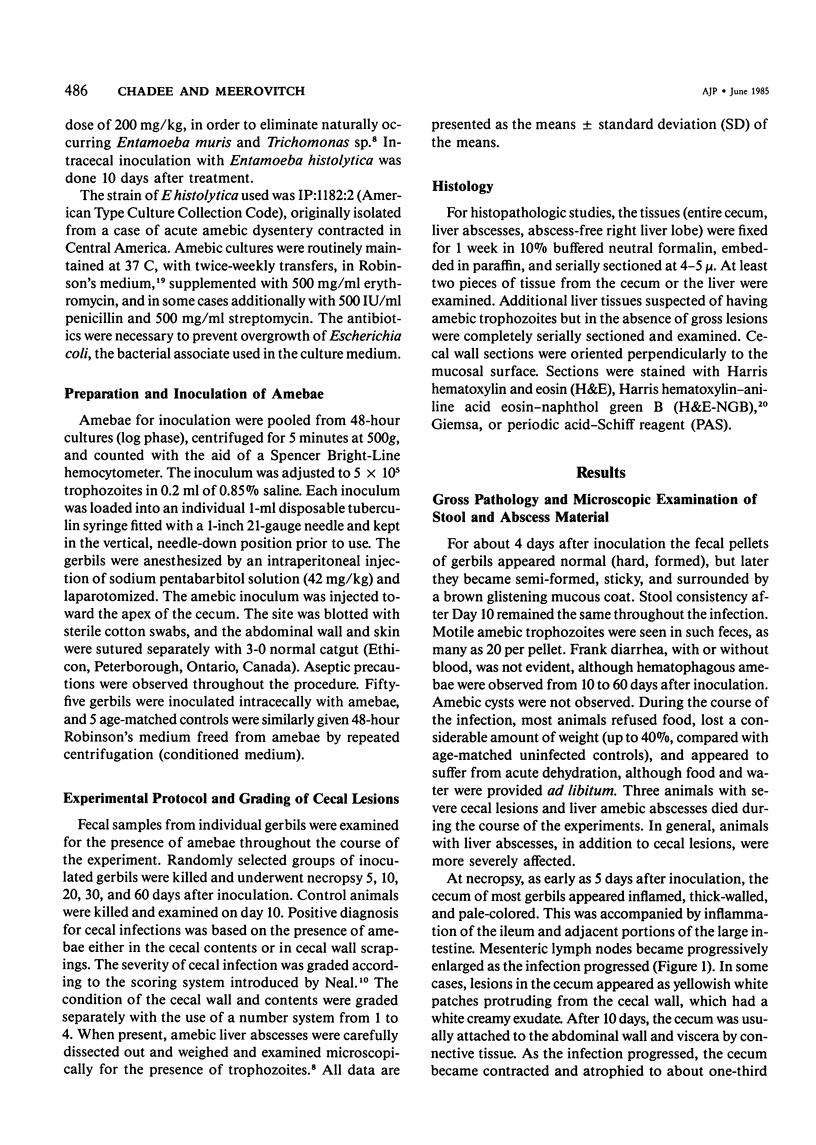
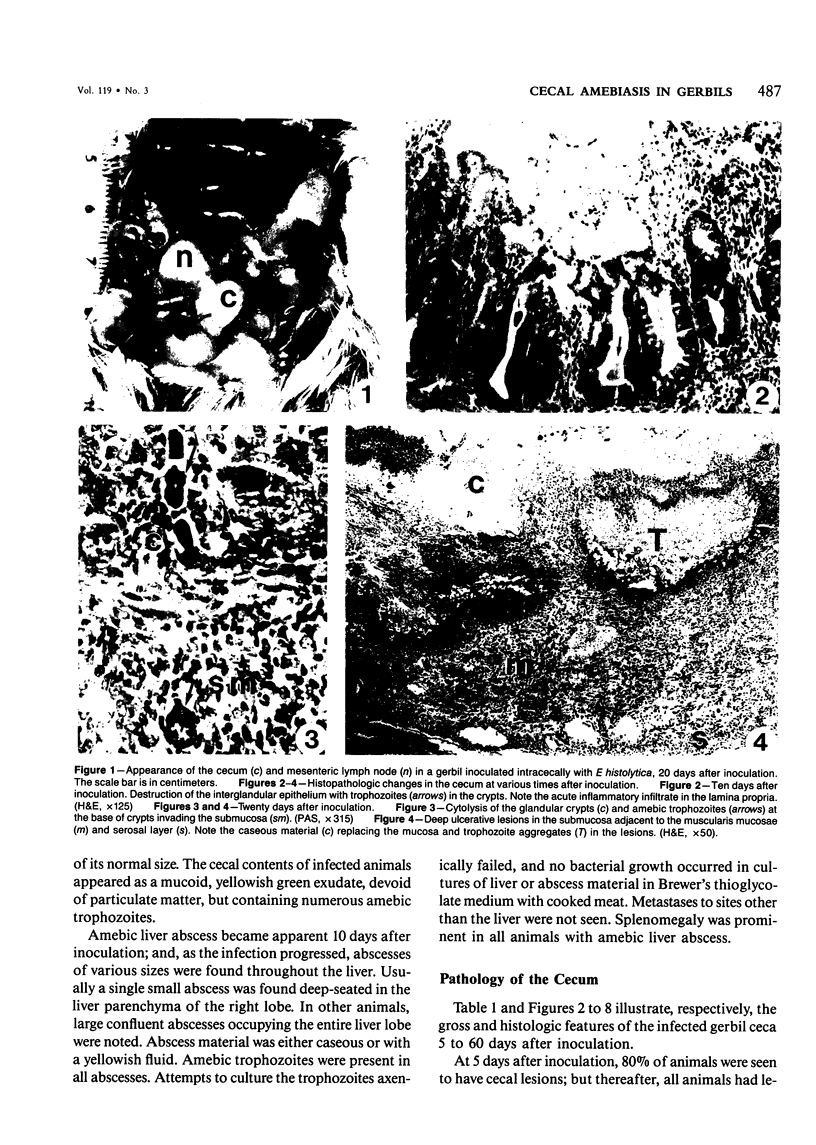

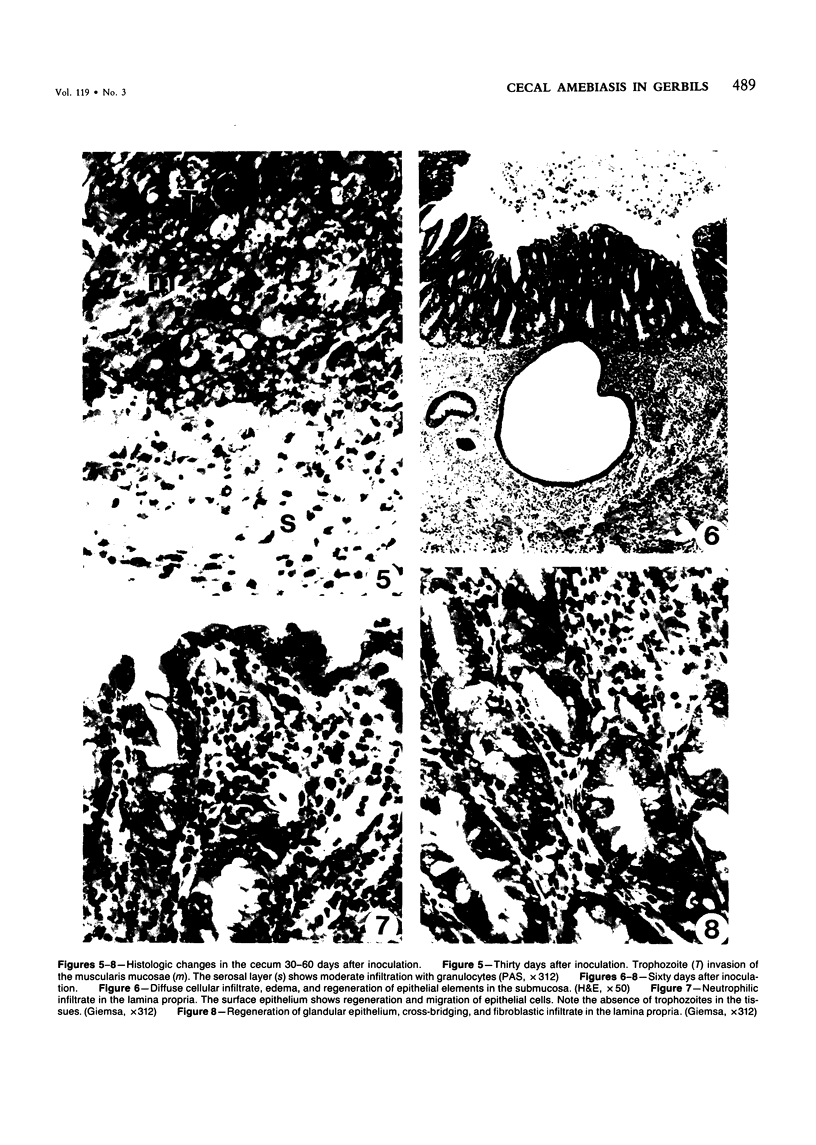


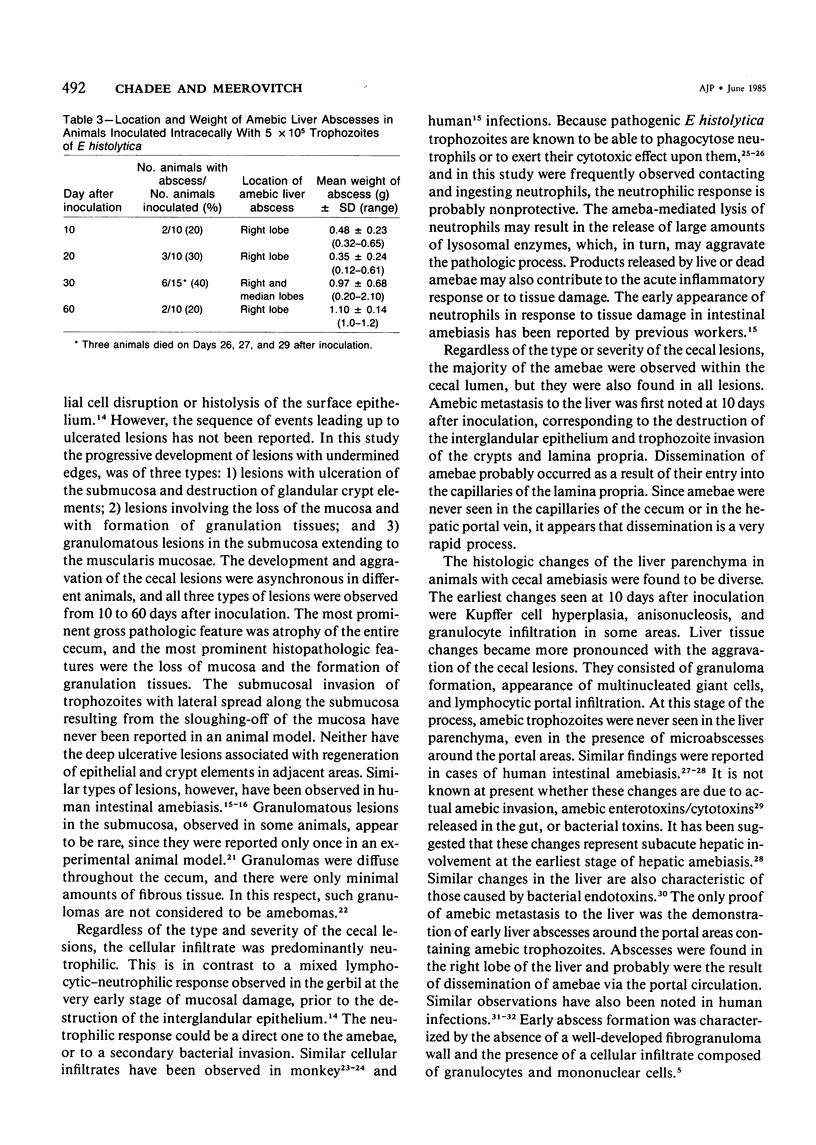

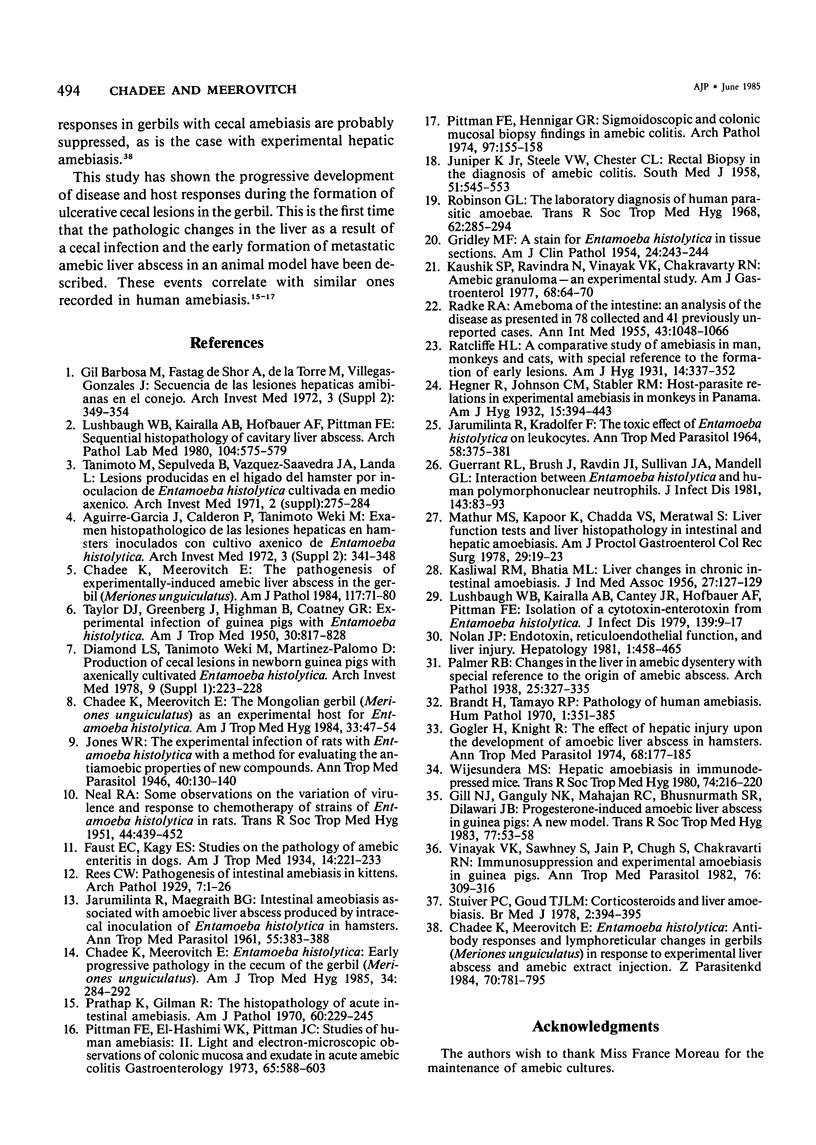
Images in this article
Selected References
These references are in PubMed. This may not be the complete list of references from this article.
- Aguirre-García J., Calderón P., Tanimoto-Weki M. Examen histopatológico de las lesiones hepáticas en hamsters inoculados con cultivo axénico de Entamoeba histolytica. Arch Invest Med (Mex) 1972;2(Suppl):341–348. [PubMed] [Google Scholar]
- BHATIA M. L., KASLIWAL R. M. Liver changes in chronic intestinal amoebiasis. J Indian Med Assoc. 1956 Aug 16;27(4):127–129. [PubMed] [Google Scholar]
- Brandt H., Tamayo R. P. Pathology of human amebiasis. Hum Pathol. 1970 Sep;1(3):351–385. doi: 10.1016/s0046-8177(70)80072-7. [DOI] [PubMed] [Google Scholar]
- Chadee K., Meerovitch E. Entamoeba histolytica: antibody responses and lymphoreticular changes in gerbils (Meriones unguiculatus) in response to experimental liver abscess and amebic extract infection. Z Parasitenkd. 1984;70(6):781–795. doi: 10.1007/BF00927131. [DOI] [PubMed] [Google Scholar]
- Chadee K., Meerovitch E. The Mongolian gerbil (Meriones unguiculatus) as an experimental host for Entamoeba histolytica. Am J Trop Med Hyg. 1984 Jan;33(1):47–54. doi: 10.4269/ajtmh.1984.33.47. [DOI] [PubMed] [Google Scholar]
- Chadee K., Meerovitch E. The pathogenesis of experimentally induced amebic liver abscess in the gerbil (Meriones unguiculatus). Am J Pathol. 1984 Oct;117(1):71–80. [PMC free article] [PubMed] [Google Scholar]
- Diamond L. S., Tanimoto Weki M., Martínez-Palomo A. Production of cecal lesions in newborn guinea pigs with axenically cultivated Entamoeba histolytica. Arch Invest Med (Mex) 1978;9 (Suppl 1):223–228. [PubMed] [Google Scholar]
- GRIDLEY M. F. A stain for Endamoeba histolytica in tissue sections. Am J Clin Pathol. 1954 Feb;24(2):243–244. doi: 10.1093/ajcp/24.2_ts.243. [DOI] [PubMed] [Google Scholar]
- Gil-Barbosa M., Fastag de Shor A., De la Torre M., Villegas-González J. Secuencia de las lesiones hepáticas amibianas en el conejo. Arch Invest Med (Mex) 1972;2(Suppl):349–354. [PubMed] [Google Scholar]
- Gill N. J., Ganguly N. K., Mahajan R. C., Bhusnurmath S. R., Dilawari J. B. Progesterone-induced amoebic liver abscess in guinea-pigs--a new model. Trans R Soc Trop Med Hyg. 1983;77(1):53–58. doi: 10.1016/0035-9203(83)90013-5. [DOI] [PubMed] [Google Scholar]
- Guerrant R. L., Brush J., Ravdin J. I., Sullivan J. A., Mandell G. L. Interaction between Entamoeba histolytica and human polymorphonuclear neutrophils. J Infect Dis. 1981 Jan;143(1):83–93. doi: 10.1093/infdis/143.1.83. [DOI] [PubMed] [Google Scholar]
- Gögler H., Knight R. The effect of hepatic injury upon the development of amoebic liver abscess in hamsters. Ann Trop Med Parasitol. 1974 Jun;68(2):177–185. doi: 10.1080/00034983.1974.11686936. [DOI] [PubMed] [Google Scholar]
- JARUMILINTA R., KRADOLFER F. THE TOXIC EFFECT OF ENTAMOEBA HISTOLYTICA ON LEUCOCYTES. Ann Trop Med Parasitol. 1964 Sep;58:375–381. doi: 10.1080/00034983.1964.11686259. [DOI] [PubMed] [Google Scholar]
- JUNIPER K., Jr, STEELE V. W., CHESTER C. L. Rectal biopsy in the diagnosis of amebic colitis. South Med J. 1958 May;51(5):545–553. doi: 10.1097/00007611-195805000-00001. [DOI] [PubMed] [Google Scholar]
- Kaushik S. P., Ravindra N., Vinayak V. K., Chakravarty R. N. Amebic granuloma--an experimental study. Am J Gastroenterol. 1977 Jul;68(1):64–70. [PubMed] [Google Scholar]
- Lushbaugh W. B., Kairalla A. B., Cantey J. R., Hofbauer A. F., Pittman F. E. Isolation of a cytotoxin-enterotoxin from Entamoeba histolytica. J Infect Dis. 1979 Jan;139(1):9–17. doi: 10.1093/infdis/139.1.9. [DOI] [PubMed] [Google Scholar]
- Lushbaugh W. B., Kairalla A. B., Hofbauer A. F., Pittman F. E. Sequential histopathology of cavitary liver abscess. Formation induced by axenically grown Entamoeba histolytica. Arch Pathol Lab Med. 1980 Nov;104(11):575–579. [PubMed] [Google Scholar]
- NEAL R. A. Some observations on the variation of virulence and response to chemotherapy of strains of Entamoeba histolytica in rats. Trans R Soc Trop Med Hyg. 1951 Feb;44(4):439–452. doi: 10.1016/s0035-9203(51)80021-x. [DOI] [PubMed] [Google Scholar]
- Nolan J. P. Endotoxin, reticuloendothelial function, and liver injury. Hepatology. 1981 Sep-Oct;1(5):458–465. doi: 10.1002/hep.1840010516. [DOI] [PubMed] [Google Scholar]
- Pittman F. E., Hennigar G. R. Sigmoidoscopic and colonic mucosal biopsy findings in amebic colitis. Arch Pathol. 1974 Mar;97(3):155–158. [PubMed] [Google Scholar]
- Pittman F. E., el-Hashimi W. K., Pittman J. C. Studies of human amebiasis. II. Light and electron-microscopic observations of colonic mucosa and exudate in acute amebic colitis. Gastroenterology. 1973 Oct;65(4):588–603. [PubMed] [Google Scholar]
- Potter E. L. In memoriam. Fred L. Adair 1878-1972. J Reprod Med. 1972 Jun;8(6):348–349. [PubMed] [Google Scholar]
- Prathap K., Gilman R. The histopathology of acute intestinal amebiasis. A rectal biopsy study. Am J Pathol. 1970 Aug;60(2):229–246. [PMC free article] [PubMed] [Google Scholar]
- RADKE R. A. Ameboma of the intestine: an analysis of the disease as presented in 78 collected and 41 previously unreported cases. Ann Intern Med. 1955 Nov;43(5):1048–1066. doi: 10.7326/0003-4819-43-5-1048. [DOI] [PubMed] [Google Scholar]
- Robinson G. L. The laboratory diagnosis of human parasitic amoebae. Trans R Soc Trop Med Hyg. 1968;62(2):285–294. doi: 10.1016/0035-9203(68)90170-3. [DOI] [PubMed] [Google Scholar]
- Stuiver P. C., Goud T. J. Corticosteroids and liver amoebiasis. Br Med J. 1978 Aug 5;2(6134):394–395. doi: 10.1136/bmj.2.6134.394. [DOI] [PMC free article] [PubMed] [Google Scholar]
- TAYLOR D. J., GREENBERG J., HIGHMAN B., COATNEY G. R. Experimental infection of guinea pigs with Endamoeba histolytica. Am J Trop Med Hyg. 1950 Nov;30(6):817–828. doi: 10.4269/ajtmh.1950.s1-30.817. [DOI] [PubMed] [Google Scholar]
- Vinayak V. K., Sawhney S., Jain P., Chugh S., Chakravarti R. N. Immunosuppression and experimental amoebiasis in guinea-pigs. Ann Trop Med Parasitol. 1982 Jun;76(3):309–316. doi: 10.1080/00034983.1982.11687546. [DOI] [PubMed] [Google Scholar]
- Wijesundera M. de S. Hepatic amoebiasis in immunodepressed mice. Trans R Soc Trop Med Hyg. 1980;74(2):216–220. doi: 10.1016/0035-9203(80)90250-3. [DOI] [PubMed] [Google Scholar]







